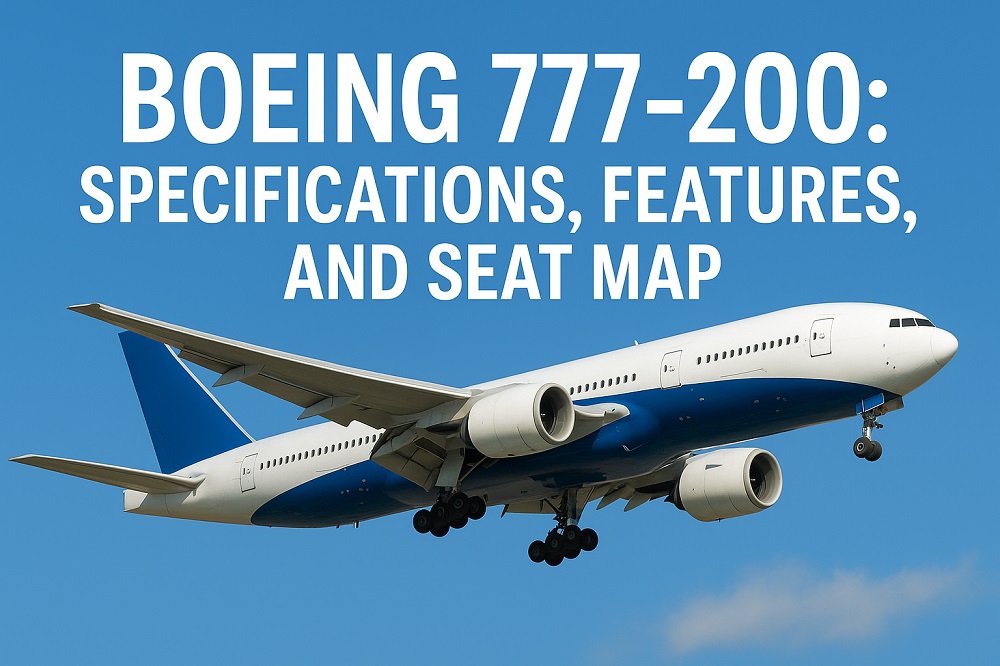Discover the remarkable Boeing 777-200, a groundbreaking aircraft that revolutionized commercial aviation with its advanced technology and exceptional performance capabilities. Let’s explore the features, specifications, and innovations that make this wide-body airliner a cornerstone of modern air travel.
👉 Aircraft engine stand for rent 👈
Overview of the Boeing 777-200
The Boeing 777-200 represents a significant milestone in aviation history as Boeing’s first fly-by-wire aircraft. Since its 1995 debut, this twin-engine jet has incorporated cutting-edge technology, including the Electronic Flight Instrument System (EFIS) and Flight Envelope Protection, enhancing both safety and operational efficiency.
The evolution of the 777-200 led to the development of the 777-200ER (Extended Range), which features:
- Increased Maximum Takeoff Mass of 297,550 kg
- Enhanced engine performance
- Extended range capability of 7,725 nautical miles
- Same airframe as the original model
- Improved fuel efficiency systems
👉 Engine Stand GE90-94B/115B 👈
Introduction to the Boeing 777-200
The aircraft’s design excellence combines advanced technology with exceptional passenger comfort. Key features include:
- Low wing position for optimal aerodynamics
- Regular mid-set tail configuration
- Underwing mounted engines
- Advanced fly-by-wire system
- Electronic Flight Instrument System (EFIS)
History and Development of the Boeing 777-200
The Boeing 777-200’s journey began in 1986 as an initiative to create a higher-capacity successor to the 767 model. The project culminated in the aircraft’s introduction in June 1995, marking a new chapter in commercial aviation history.
The 777-200LR (Longer Range) variant, introduced in 2005, further pushed engineering boundaries with:
- Range capability of 9,395 nautical miles
- Advanced wing design shared with 777-300ER
- Enhanced engine power systems
- Improved aerodynamic efficiency
Technical Specifications of the Boeing 777-200
| Specification | Standard 777-200 | 777-200ER |
|---|---|---|
| Typical Passenger Capacity | 298 (three-class) | 298 (three-class) |
| Maximum Range | 5,240 nautical miles | 7,725 nautical miles |
| Cruise Speed | Mach 0.84 | Mach 0.84 |
Dimensions and Capacity
| Dimension | Measurement |
|---|---|
| Length | 63.7 meters (209 feet 1 inch) |
| Wingspan | 60.9 meters (199 feet 11 inches) |
| Height | 18.5 meters (60 feet 9 inches) |
| Cargo Capacity | 6 pallets or 14 LD-3 containers |
Engine and Performance
The aircraft offers engine options from three major manufacturers:
- General Electric
- Pratt & Whitney
- Rolls-Royce (Trent 875: 73,400 lb thrust, Trent 877: 76,000 lb thrust)
Range and Efficiency
The Boeing 777-200’s impressive range capabilities and efficiency features include:
- Standard variant range: 5,240 nautical miles (9,700 km)
- ER variant range: 7,725 nautical miles (14,305 km)
- Advanced aerodynamic profile
- Optimized fuel consumption
- Reduced environmental impact
👉 Engine Stand Trent 800 For Lease 👈
Features and Design of the Boeing 777-200
The Boeing 777-200 represents a technological breakthrough in commercial aviation, distinguished as Boeing’s first fly-by-wire airliner. The aircraft incorporates several innovative features:
- Advanced Electronic Flight Instrument System (EFIS)
- Sophisticated Flight Envelope Protection
- Wide-body configuration for enhanced cabin space
- Low wing position for optimal aerodynamics
- Regular mid-set tail design
- Underwing mounted engines for improved efficiency
- Tricycle retractable landing gear for stable operations
Aerodynamic Design
The Boeing 777-200’s aerodynamic excellence stems from its pioneering development process, being the first commercial aircraft designed entirely using computer-aided design (CAD). Through CATIA, a sophisticated 3D software system from Dassault Systèmes and IBM, engineers optimized every aerodynamic aspect before physical construction.
Key aerodynamic innovations include:
- Advanced wing design balancing lift and drag
- Cutting-edge materials for enhanced flex characteristics
- Strategic engine placement for improved balance
- Optimized wing flex for fuel efficiency
- Reduced cabin noise through innovative design
Passenger Comfort and Amenities
The Boeing 777-200 elevates the passenger experience with comprehensive entertainment and comfort features:
- 15.4-inch HD-capable touchscreen monitors at each seat
- Extensive entertainment library including:
- 75 movies
- 150+ TV programs
- 350+ audio selections
- 15 interactive games
- AC power outlets throughout the cabin
- Internet connectivity
- Spacious overhead bin storage
- Optimized cabin pressure and humidity control
👉 Engine Stand Trent 800 Rollover 👈
Boeing 777-200 Seat Map and Configuration
| Class Configuration | Seating Capacity |
|---|---|
| Three-Class Layout | 305 (24 First / 54 Business / 227 Economy) |
| Two-Class Layout | 400 (30 First / 370 Economy) |
| Single-Class Layout | 500 (418 Premium Economy) |
Seating Classes and Layout
The aircraft features a versatile seating arrangement across different classes:
- First Class: 2-3-2 configuration at front
- Business Class: 2-2-2 or 2-3-2 arrangement
- Economy Class: 3-3-3 or 3-4-3 layout
Economy, Economy Plus, and United First
| Class Type | Features |
|---|---|
| United First | Premium amenities, enhanced services |
| Economy Plus | 35-inch seat pitch, 78 seats, 17.1-inch width |
| Economy | 31-inch pitch, 258 seats, 17.1-inch width |
Boeing 777-200 in Service with United Airlines
United Airlines pioneered the commercial operation of the Boeing 777-200, receiving its first aircraft on May 15, 1995, and conducting the inaugural commercial flight on June 7, 1995. The aircraft serves as a cornerstone of United’s long-haul operations, primarily operating on:
- US transcontinental routes
- Hawaiian destinations
- Select international services
- High-demand domestic routes
👉 Engine Stand Trent 800 Basic Transport 👈
Destinations Served by the Boeing 777-200
United Airlines strategically deploys its Boeing 777-200 fleet across diverse routes, demonstrating the aircraft’s operational versatility. The primary routes include:
- US transcontinental services
- Hawaiian destinations
- International routes (ER variant), including:
- Dubai
- Quito
- Guayaquil
- Osaka
The aircraft’s impressive range and passenger capacity make it an ideal choice for both high-density domestic routes and long-haul international services. This flexibility enables United to adapt its network strategy effectively, optimizing the 777-200 fleet’s utilization across various route types and distances.
Customer Experience and Feedback
| Cabin Class | Notable Feedback |
|---|---|
| Polaris First Class | Seats 2C and 2H highly rated for comfort and storage space; enhanced experience with new Polaris lounge |
| Seat 1A | Often utilized by crew for rest and storage |
| Economy Class | Seat 32A praised for excellent legroom; some areas noted for limited inflight entertainment access |
Overall passenger feedback has been predominantly positive, particularly regarding comfort and amenities. However, experiences vary significantly based on seat location and service class, highlighting the importance of strategic seat selection when booking. The diverse feedback across cabin classes demonstrates United’s varied service offerings on their 777-200 fleet, catering to different passenger preferences and needs.
Read more:
- Boeing 707: History, Features, and Impact on Aviation
- Boeing 777: Features, Specifications, and Insights
- Boeing 737 Max: Latest Updates and Safety Information
- Boeing 737-900: Specifications, Features, and Seat Map
- Boeing 717: Specifications, Features, and Flight Experience
- Boeing 767: Specifications, Features, and Insights
- Boeing 737-700: Features, Specifications, and Seat Map
- Boeing 787-9: Features, Specifications, and Insights
- Boeing 767-400: Specifications, Features, and Seat Maps

